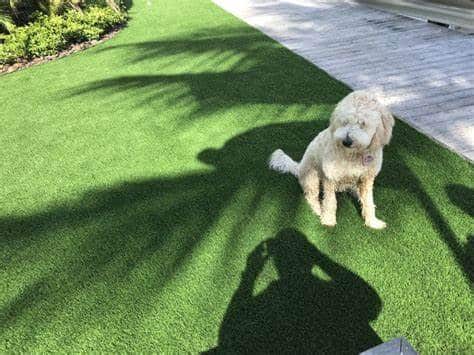What Are The Pets Induced Problems Solved By Artificial Grass In Carlsbad?
 Pets bring immense joy and companionship to our lives, but they can also create some challenges, particularly when it comes to maintaining a pristine lawn or backyard. From urine stains to muddy paws, pet-related issues can wreak havoc on natural grass. Fortunately, artificial grass offers an innovative solution to these problems. In this article, we will explore five common pet-induced problems that can be effectively solved by installing artificial grass.
Pets bring immense joy and companionship to our lives, but they can also create some challenges, particularly when it comes to maintaining a pristine lawn or backyard. From urine stains to muddy paws, pet-related issues can wreak havoc on natural grass. Fortunately, artificial grass offers an innovative solution to these problems. In this article, we will explore five common pet-induced problems that can be effectively solved by installing artificial grass.
- One of the most significant challenges pet owners face is dealing with urine stains and odors on their natural grass. The high nitrogen content in pet urine can damage and discolor the grass, leaving unsightly brown patches. Additionally, the smell can linger, making your outdoor space less enjoyable. Artificial grass is designed to resist staining and is virtually impervious to urine. Its porous backing allows urine to drain through, preventing the buildup of odors and making cleanup a breeze. Regular rinsing and the occasional application of a pet-friendly deodorizer will keep your artificial lawn smelling fresh.
- Rainy days often lead to muddy pawprints tracking indoors, which can be a headache to clean up. With artificial grass, this problem becomes a thing of the past. Synthetic turf does not become a mud pit during wet weather, ensuring your pets can play outside without turning into a muddy mess. Plus, it means less dirt and mud being dragged inside your home.
- Some pets have a natural instinct to dig or scratch the ground, which can be frustrating when it comes to maintaining a well-manicured lawn. Artificial grass offers a durable surface that discourages digging and scratching, preserving the integrity of your outdoor space. This not only keeps your yard looking pristine but also prevents your pets from injuring themselves while digging.
- Natural grass can harbor allergens like pollen and mold, which can exacerbate allergies for both humans and pets. Additionally, it can attract pests like fleas and ticks that can harm your furry friends. Artificial grass, being hypoallergenic and resistant to pests, provides a safer environment for your pets to enjoy without the risk of allergies or infestations.
- Maintaining a natural lawn often requires regular mowing, watering, and fertilizing. With artificial grass, you can say goodbye to these time-consuming tasks. Synthetic turf requires minimal maintenance, saving you both time and money in the long run. Cleanup is a breeze as well, with solid waste easily removed and liquid waste draining through the turf.
FAQs
Is Artificial Grass Safe For Pets?
Yes, artificial grass is safe for pets. It is designed to be pet-friendly, with features like drainage systems that prevent odors and non-toxic materials that are safe for your furry friends.
Can My Pets Still Play And Exercise On Artificial Grass?
Absolutely! Artificial grass provides a comfortable and durable surface for pets to play, run, and exercise. Its resilient nature makes it suitable for active pets.
How Long Does Artificial Grass Last, And Is It Worth The Investment?
High-quality artificial grass can last up to 15-20 years, making it a cost-effective investment in the long run. It eliminates the need for ongoing lawn maintenance and provides a clean and attractive outdoor space for both you and your pets.
Conclusion
Artificial grass is a game-changer for pet owners, solving numerous problems that can arise from having furry companions in your home. From eliminating urine stains and muddy pawprints to reducing allergens and discouraging digging, synthetic turf offers a wealth of benefits. With low maintenance requirements and a long lifespan, artificial grass is a worthwhile investment for pet owners looking to create a pet-friendly and attractive outdoor space. Say goodbye to the headaches of natural grass and say hello to a clean, beautiful yard that both you and your pets can enjoy. For more information, contact Artificial Turf Carlsbad at (760) 991-3400.

